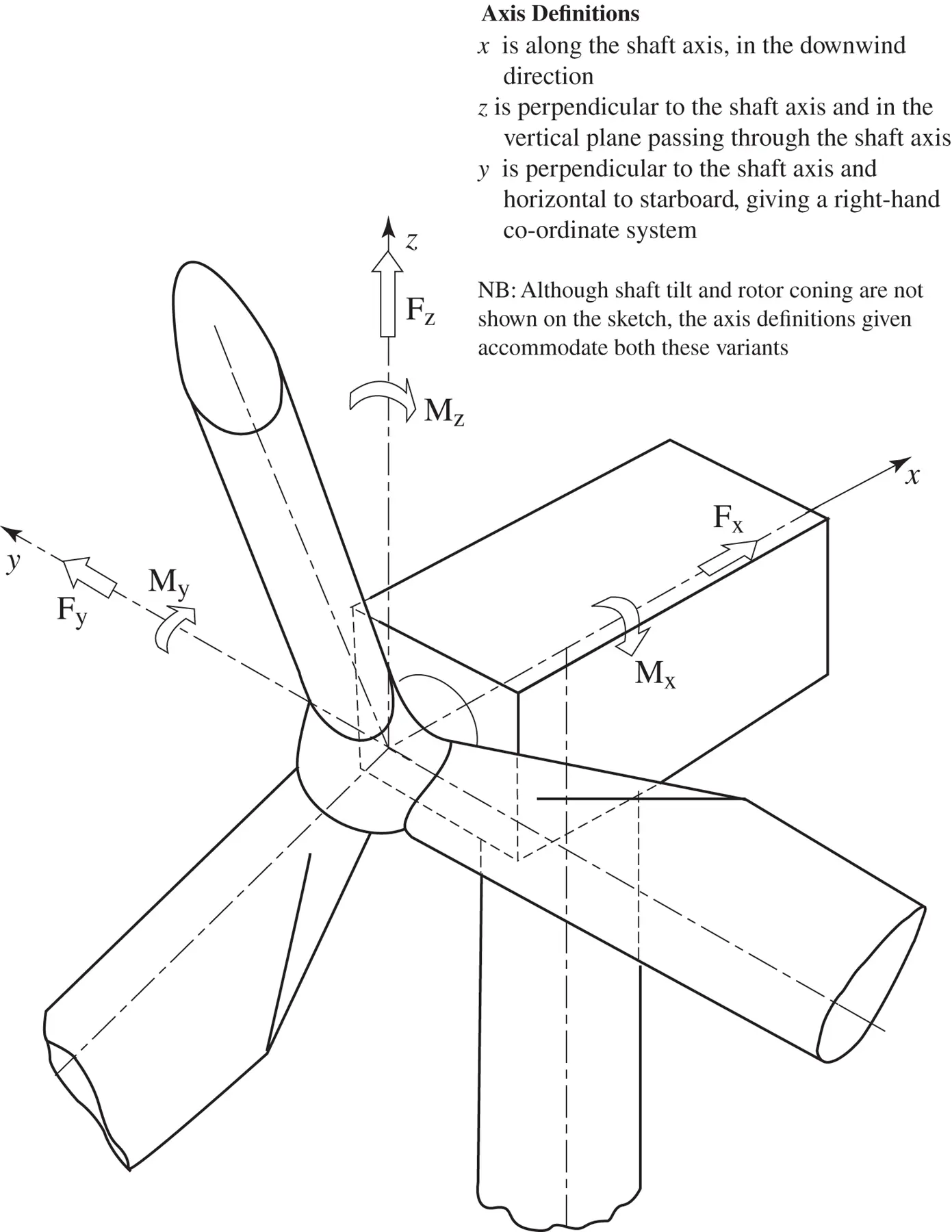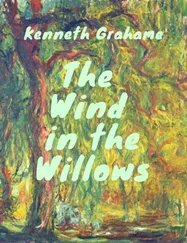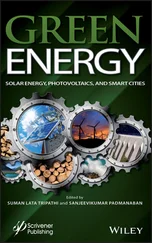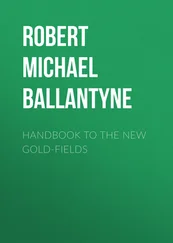
Figure C2Fixed coordinate system for hub loads and deflections, and positions with respect to hub.
1
Introduction
1.1 Historical development of wind energy
Windmills have been used for at least 3000 years, mainly for grinding grain or pumping water, while the wind has been the essential source of power in sailing ships for even longer. From medieval times, horizontal axis windmills were an integral part of the rural economy throughout Europe and only fell into disuse with the advent of cheap fossil‐fuelled stationary engines and then the spread of rural electrification (Musgrove 2010).
The use of windmills (or wind turbines) to generate electricity can be traced back to the late nineteenth century with the 12 kW direct current windmill generator constructed by Charles Brush in the USA and the research undertaken by Poul la Cour in Denmark. However, for much of the twentieth century, there was little interest in using wind energy, other than for battery charging for remote dwellings; these low power systems were quickly removed once more reliable and higher power electricity supplies from the public electricity network became available. One notable development was the 1250 kW Smith–Putnam wind turbine constructed in the USA in 1941. This remarkable machine had a steel rotor 53 m in diameter, full‐span pitch control, and flapping blades to reduce loads. Although a blade spar failed catastrophically in 1945, it remained the largest wind turbine constructed for some 40 years (Putnam 1948).
Golding (1955) and Spera (1994) provide a fascinating history of early wind turbine development. They record the 100 kW 30 m diameter Balaclava wind turbine in the USSR in 1931 and developments in the UK during the 1950s, including the John Brown Engineering, 15 m diameter turbine erected on a high wind speed site on Orkney and the Andrea Enfield 100 kW 24 m diameter pneumatic design. In this novel turbine, hollow blades, open at the tip, were used to draw air up through the tower, where an air turbine drove the generator. In Denmark, the 200 kW 24 m diameter Gedser machine was built in 1956 and operated for 11 years to provide an important foundation of knowledge for the later development of early commercial turbines. Electricité de France tested a 1.1 MW 35 m diameter turbine in 1963, while in Germany, Professor Ulrich Hutter constructed a number of innovative, lightweight turbines in the 1950s and 1960s. In spite of these technical advances and the enthusiasm of Golding at the Electrical Research Association in the UK, among others, there was little sustained interest in wind generation until the price of oil rose dramatically in 1973.
The sudden increase in the price of oil stimulated a number of substantial, government‐funded programmes of research, development, and demonstration. In the USA, this led to the construction of a series of prototype turbines starting with the 38 m diameter 200 kW Mod‐0 in 1975 and culminating in the 97.5 m diameter 3.2 MW Mod‐5 in 1987. Similar programmes were pursued in Germany with the Growian, 100 m diameter 3 MW turbine built in 1982 and in the UK with the LS‐1 60 m diameter 3 MW turbine in 1988, both of which had two blades (Hau 2010). There was considerable uncertainty as to which architecture might prove most cost‐effective, and several innovative concepts were investigated at full scale. In Canada, a 4 MW vertical axis Darrieus wind turbine was constructed, and this concept was also investigated in the 34 m diameter Sandia vertical axis test facility in the USA. In the UK, an alternative, vertical axis design using straight blades in an ‘H’ type rotor was proposed by Dr Peter Musgrove and a 500 kW prototype constructed. In 1981, the innovative Schachle‐Bendix horizontal axis 3 MW wind turbine was built and tested in the USA (Spera 1994). This used hydraulic transmission, and, as an alternative to a bearing at the top of the tower and yaw drive, the entire structure was orientated into the wind. Several prototypes used a single blade and counterweight, including the 600 kW MBB Monopteros in 1985 (Hau 2010).
Much important scientific and engineering information was gained from these government‐funded research programmes, and the prototypes generally worked as designed. However, the problems of operating very large wind turbines, unmanned and in difficult wind climates, were often underestimated, and the reliability of the prototypes was not good. At the same time as the multi‐megawatt prototypes were being constructed, private companies, often with considerable state support, were constructing much smaller and simpler turbines for commercial sale. In particular, the financial support mechanisms in California in the mid‐1980s resulted in the installation of a very large number of quite small (around 100 kW) wind turbines of various designs. Many of these designs also suffered from various problems, but, being smaller, they were easier to repair and modify.
The so‐called ‘Danish wind turbine’ concept emerged of a three blade, upwind, stall regulated rotor and a fixed speed, induction generator. This design was installed widely in Denmark and Germany, supported by Feed‐in Tariffs that paid a fixed premium rate for electricity generated by wind energy. The deceptively simple architecture of the Danish wind turbine proved to be remarkably successful and was implemented on turbines as large as 60 m in diameter and at power ratings of up to 1.5 MW. However, at larger rotor diameters and generator ratings, the architecture ceases to be effective because, with larger rotors, aerodynamic stall is increasingly difficult to predict, and the larger induction generators were no longer able to provide enough damping and torsional compliance in the drive train. Also, the requirements of the electrical Transmission System Operators for connecting wind farms to the network become very difficult to meet with a simple fixed speed induction generator. Hence, as the size of commercially available turbines approached or exceeded that of the large prototypes of the 1980s, the concepts investigated then of variable‐speed operation and full‐span control of the blade pitch as well as advanced materials and modern control systems were increasingly adopted. The evolution of modern wind turbines is described in Serrano‐González and Lacal‐Arántegui (2016).
In 1991, the first offshore wind farm, consisting of 11 450 kW wind turbines, was constructed at Vindeby, 3 km off the coast of Denmark. Throughout the 1990s, small numbers of offshore wind turbines were placed close to shore, while in 2002, the Horns Rev, 160 MW wind farm, was constructed some 20 km off the western coast of Denmark. At the time of writing (2020), there was around 29 GW of offshore wind energy capacity in operation (Global Wind Energy Council 2020), concentrated mainly off the coasts of northern Europe and eastern China. There are a number of offshore wind farms of capacity greater than 500 MW, and even larger installations are under construction or planned. The wind turbines installed in the early offshore wind farms were marinised conventional designs that had been proved onshore. More recently, very large wind turbines designed specially for transport directly by sea from the factory to the offshore site have been installed. Further, the possibility of higher blade tip speeds because of more relaxed noise constraints and a reduced emphasis on the visual appearance of wind farms far from land continue to lead to interest in the development of very large, lower solidity rotors (Jamieson 2018).
The stimulus for the development of wind energy in 1973 was the increase in the price of oil and concern over limited fossil fuel resources. From around 1990, the main driver for the use of wind turbines to generate electrical power has been the very low CO 2emissions, over the entire life cycle of manufacture, installation, operation, and de‐commissioning, and the potential of wind energy to help mitigate climate change. In 2007, the European Union established a policy that 20% of all energy should be from renewable sources by 2020. Because of the difficulty of using renewable energy for transport and heat, this implies that in some countries 30–40% of electrical energy should come from renewables, with wind energy playing a major part. Energy policy continues to develop rapidly, with the European Union extending its target for the share of energy to come from renewables by 2030 to 32% and many countries now adopting a commitment to reduce or eliminate greenhouse gas emissions before 2050.
Читать дальше













